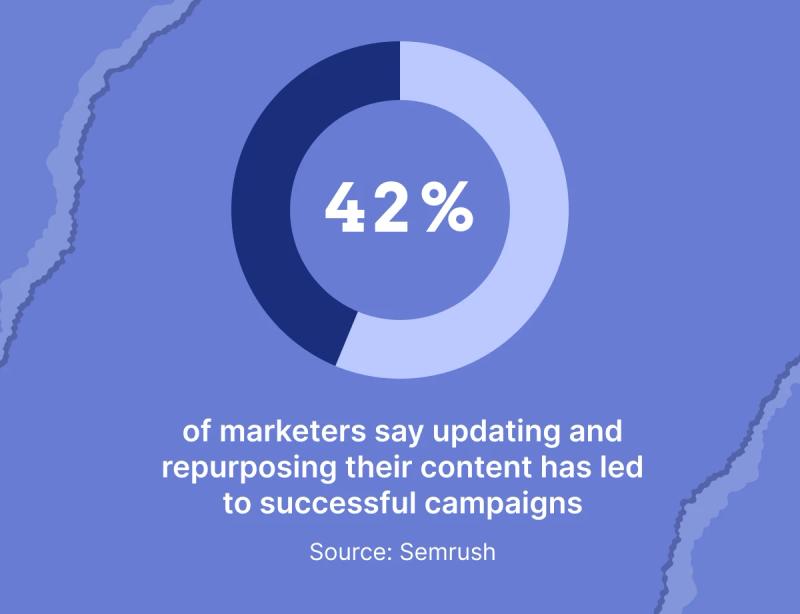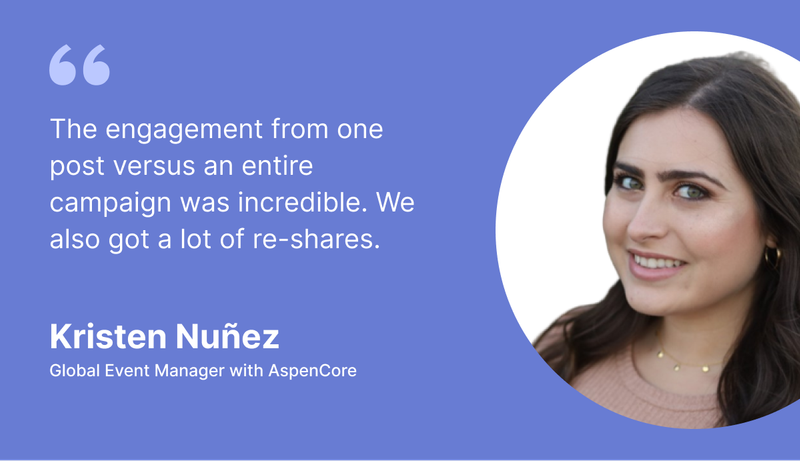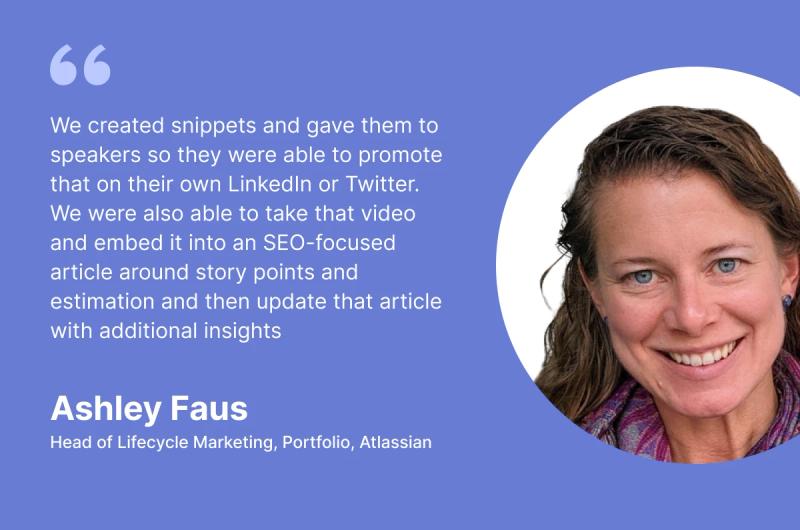Why B2B Marketers Should Care About Repurposing Content Across Channels

Table of Contents
- Table of contents
- What is content repurposing?
- Why repurpose video content across channels?
- Benefits of video-first content repurposing
- What channels to repurpose video content for?
- How to effectively repurpose video content
- Measuring the success of repurposed video content
- Goldcast + Content Lab = Easy, breezy, video-first content
Maximize Your Marketing ROI
Join 10,000 other marketers already getting the best tips on running engaging events that boost pipeline and create raving fans.
Remember when “repurposing” was a dirty word? In a role defined by having the creativity to do more with less and prove it, B2B marketers have prided themselves in the ability to produce original content for each and every digital channel.
Not anymore. Marketing in the 2020s isn’t about carefully dominating one social media channel, or email blasting a list of tepid-at-best leads.
Today, 75% of B2B buyers use social media to make decisions, 82% of consumers have made a purchase because of a video, and 42% of marketers say updating and repurposing their content has led to successful campaigns.
Repurposing content is no longer taboo. It’s necessary. And in a saturated B2B tech landscape, you can’t afford to overlook it.
Today, we’re diving deep into the benefits of content repurposing in 2024. We’ll look at why video is the best place to start and how AI products like Content Lab can help you create a high-impact content flywheel with high-quality video at the center.

Table of contents
- What is content repurposing?
- Why repurpose video content across channels?
- Benefits of video-first content repurposing
- What channels to repurpose video content for?
- How to effectively repurpose video content
- Measuring the success of repurposed video content
What is content repurposing?
As the name suggests, content repurposing is the process of giving new purpose to a brand’s existing content by repackaging it into different formats, or for different channels.
By making the most of a brand’s existing content, marketers can maximize reach, increase search engine optimization (SEO), and secure a stronger return on investment (ROI) on their marketing efforts.

Why repurpose video content across channels?
We’ve said it before, we’ll say it again: if content is queen, video is heir to the throne.
According to HubSpot’s latest State of Marketing report, 17% of marketers are already reporting ROI on short-form videos. And 30% of marketers who don’t already use short-form video are planning to start this year.
Until now, the amount of reviewing, time-stamping, and editing required to generate just one professional-looking video was simply too time and cost prohibitive for many marketing teams. Maybe your process looks something like what Kristen from AspenCore describes:
But with a whole new set of AI-powered tools in the market, producing high-quality short-form videos has never been faster, easier, or more affordable.
Benefits of video-first content repurposing
As a B2B marketer competing in a content landscape defined by always-on snackable content, you need to find new ways to “consumerize” your content.
By using a variety of channels and formats to extend your brand’s reach, you can deliver consistent messaging across multiple touch points and get more ROI out of every content asset.
Here are just some of the benefits of a video-first content repurposing strategy:
- Maximized ROI: Viewers retain 95% of a video's message compared to 10% when reading text. With stats like that, it’s no wonder video ads tend to have cheaper cost per engagement than other formats. Video content maximizes the return on your original investment by getting your message across faster and in a way that sticks.
- Increased engagement and visibility: In a world where so many of us communicate with friends and family using an endless thread of TikToks and Reels, social video is known to generate 1200% more shares than text and image content combined.
- Enhanced SEO: Videos now constitute 65% of all internet traffic. By adding a video to your blog posts and web pages, you not only enhance your brand’s credibility, you also increase your SERP ranking, backlink profile and clickthrough rates (CTRs).
- Increased thought leadership: 90% of marketers say video increases their brand awareness. By positioning subject matter experts at the center of your strategy, repurposing video content can help establish and reinforce industry authority.
Last but by no means least, a video-first content repurposing strategy empowers your brand to show up for prospects however, wherever, and whenever they like.
With a steady stream of strategically placed content, you can nurture potential customers through the sales funnel in a way that feels organic, never forced.
[Content Lab lets you repurpose your event content into blogs, webinars, and more. Learn how the team at ActiveCampaign generated LinkedIn content to promote their Leap Day Extravaganza event live in real-time.]
What channels to repurpose video content for?
Once you understand the benefits of video-first content repurposing, it’s time to think about where to disseminate all that golden material.
While social media may be the obvious choice, repurposed video content can also deliver increased results via your blogs, email newsletters, future events, and more.
Here are some of the best ways to distribute your video content:
- Social media content
- Blog posts
- Email newsletter content
- On-demand event hubs
- Video podcasts
- Video ads
- Product launch emails and events
- Landing pages
- Sales follow-ups
To really maximize the effectiveness of your videos across platforms, you’ll also want to plan for a variety of formats for your audience to engage with.
Here are some of the top formats to consider:
- Explainer videos
- Tutorials and how-to videos
- Team culture videos
- Case studies
- Customer testimonials
- Webinars
- Live streams
- Live videos and events
- Event recap videos
- New product demos
- Product videos
- Brand videos
- Expert panels
- Interviews
The reality is, with the rise of generative AI, anyone can create a mass amount of content.
But doing content well, then doing it again and again at a high pace—that’s a whole different story. And it’s where the right tools and execution strategy are key.

How to effectively repurpose video content
For most B2B marketers, the question isn’t where to post your videos or which formats to create, it’s: where the heck are we going to source all this video content in the first place?
That’s where digital events, webinars and video podcasts enter the conversation.
Unlike paid actors and stock footage, video content from events are authentic, conversational, and interactive by nature. You just need to know what to look for and how to get the most out of it.
To strike the balance between velocity, relevance, and quality, start with the following steps.
1. Audit
Making the “thing” is just step one. Once you’ve put the time, effort, (blood, sweat, and tears) into your event pillar content, the temptation is to take a big sigh of relief—then lift your chin and move swiftly onto the next thing.
But every time you do, you’re leaving major repurposing opportunities on the table.
Here are some tips to squeeze every ounce of ROI out of the content you worked so hard to create:
- Review your deep dive events, webinar series, podcast episodes or other long-form source content to pinpoint which moments struck the biggest chord with your audience. If you’re using an events platform like Goldcast, you can choose from over 16 event activity triggers to pinpoint the moments with the best engagement.
- Look at past engagement data on social videos, including your YouTube channel, LinkedIn, and other top B2B marketing channels to see which short-form formats typically do the best with your audience.
- Audit the customer journey to identify common questions, objections, or other hurdles that could slow the conversion process. With a deeper understanding of what content prospects need and when, you’ll be better prepared to identify which clips and snippets to create.

2. Adapt
Once you’ve narrowed down your topics and formats, it’s time to roll up your repurposing sleeves and get technical.
Here are some of the key questions to consider when adapting your video content for multiple other channels:
- Which channels will you use for distributing your content?
- Which formats do you need to create?
- Which channels require vertical vs. horizontal clips?
- What are the technical requirements for each of these channels?
- What are the individual steps that go into your content repurposing assembly line?
- What tools will you use at each stage of the process?
These days, expectations for high-quality video are high.
Whether you’re simply transforming your video transcripts into blog posts or cherry-picking the top highlights from your latest expert masterclass to use in your targeted event follow-ups, make sure your video is properly formatted for a seamless viewing experience on every platform.

3. Execute
The reality with content repurposing is that it’s just as much a mindset as it is a process.
The elements of your content flywheel won’t look the same as everyone else's, but no matter which formats and channels you use, the steps for repurposing your video content are almost always the same.
Make sure you have a dedicated team member for each of the following steps:
- Creating: If you’re not already using a professional-grade platform like Goldcast, ensure that the designated individual overseeing the filming has a keen eye for quality content.
- Curating: Know who’s responsible for reviewing the video clips, selecting the most relevant ones, and determining the key elements that will captivate your audience. This step often includes rearranging, trimming, and replacing clips until you’ve got your desired snippets.
- Editing: Post-production is where the magic happens. Make sure the person in charge of this part of the process understands not only what constitutes exceptional video content, but also how to shape it and customize it with your branding for maximum impact.
- Writing: Make sure you have an expert writer on standby to help you promptly generate compelling copy for sharing the video clip on social media, in email marketing, blog posts, follow-up communications, or anywhere else where you’ll be distributing your content.
- Publishing: Know who’s responsible for the seamless distribution of each video clip on each channel.
Tools like Content Lab can help you repurpose more content in less time by taking many of the above tasks off your team’s plate.
Measuring the success of repurposed video content
As great as it is to get more out of each and every piece of video content you create, a modern repurposing strategy is about so much more than chopping up one long video into several others.
It’s also about driving increased results at every stage of the customer lifecycle. And for that, you’ve got to be ready to track and measure your results.
Here are three key factors to keep in mind as you refine your repurposing strategy:
- Know your metrics: Different brands use video in different ways. Proving ROI on your campaigns starts with knowing which metrics you’ll track. Whether it’s engagement rates, conversions, or increased traffic and SEO rankings, the key is to know where you started and what you’ll measure along the way.
- Measure your video KPIs: From Google Analytics to Buzzsumo, there’s no shortage of tools you can use to track your video KPIs. If you’re already using a platform like Goldcast to host your pillar content, you can seamlessly transfer engagement data into your CRM using a number of integrations with tools like HubSpot, Marketo, and Salesforce.
- Review, rinse, and repeat: Real repurposing work is never done. Whether weekly, monthly, or quarterly, set a regular cadence for checking in on your KPIs and using those insights to continually refine and optimize your strategy.
Goldcast + Content Lab = Easy, breezy, video-first content
In an age where attention spans are only getting shorter, a video-first content repurposing strategy can position your brand front-and-center with prospects in a way that feels authentic and engaging.
And with Content Lab, what would have normally taken thousands of dollars and weeks to do, can now happen in a matter of minutes and at a fraction of the cost.
Get more out of every video. Try Content Lab today.
Transform Your Video Marketing with AI
Stay In Touch
Platform
Resources
© 2025 Copyright Goldcast, Inc. All rights reserved.





 Upcoming Events
Upcoming Events Event Series
Event Series On-Demand Events
On-Demand Events

